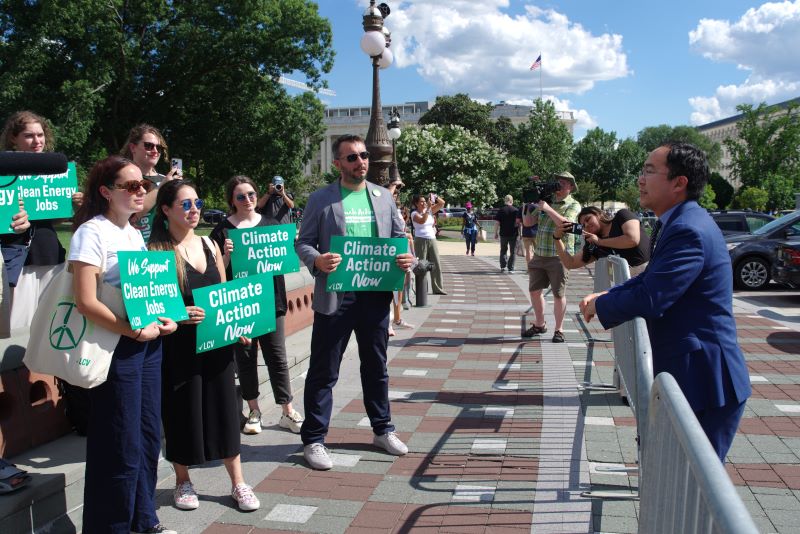With U.S. President-Elect Donald Trump set to return to the White House and a Republican-controlled Congress in place, the fate of President Joe Biden’s signature climate law is uncertain.
Political pundits do not expect a complete repeal of the Inflation Reduction Act (IRA). Rather, scalpels will likely be taken to the law which ushered in nearly $370 billion in funding for clean and lower-carbon energy projects and initiatives. Several provisions in the law could be impacted, but no one knows what the future will bring.
As investment trends shift amid growing energy needs, energy companies are still working to provide reliable and affordable energy while minimizing environmental impacts. However, developers reliant on incentives such as tax credits, grants and loans to sweeten project economics are concerned about which parts of the IRA the new Congress and Trump administration will attempt to roll back.
Trump has already pledged to rescind unspent IRA funds. While the IRA didn’t have bipartisan support before its passage, the benefits—including jobs—that the Democrat-backed law has brought to Republican-led states may have altered some viewpoints.
It’s a challenging period for taxpayers, said Tim Urban, the Washington D.C.-based senior principal who leads the tax policy practice at Bracewell.

“We are at a weird intersection of the implementation of IRA, [which] is not complete, and some of the very, very significant tax policy questions and tax legal questions haven’t yet been answered,” Urban said. “The [Biden] administration is on a mission now to try to publish as much guidance as possible before the end of the year and barring that, before the end of the presidential term.”
At the same time, taxpayers who are considering building facilities, buying equipment or producing lower carbon energy resources like hydrogen or renewable methanol face a conundrum, he added. “They’re trying to get the best deal they can … in the waning days of the Biden-Harris administration” and Treasury regulations are needed to implement credits. But an incoming president with a congressional majority made up of Republicans who voted against the IRA want “another sort of bite of the apple.”
Taking the IRA to bits won’t be easy, and as history has shown with other big pieces of legislation signed into law, unlikely, experts say.
Risks, opportunities

There was a lot of campaign rhetoric about blowing up the IRA, said Ken Irvin, co-leader of Sidley’s global Energy and Infrastructure practice. Realistically, however, some lawmakers are recognizing that money has been spent on projects funded in part by the IRA—and the investments are good ones.
A group of Republican congressmen even urged House Speaker Mike Johnson in a letter prior to the November 2024 election not to repeal clean energy credits in the IRA.
“IRA provisions for clean hydrogen, carbon sequestration, advanced manufacturing, biofuels, those all seem consonant with Trump 2.0 and the philosophy there,” Irvin said. “The EV [electric vehicle] tax credit… Mr. [Elon] Musk doesn’t seem bothered by getting rid of that, and Mr. Trump wants to roll back the EV mandate. So, that one may be in jeopardy” along with some clean energy incentives.
The Biden administration had set a target for 50% of all new vehicle sales to be electric by 2030 and rolled out regulations to help it get there. In March, the U.S. Environmental Protection Agency (EPA) released strict car emissions standards for light-duty and medium-duty vehicles with model years 2027 and later. But the rule prompted opposition and litigation. The House voted in September to repeal the rule as some called it an “EV mandate.”
Trump’s platform included a promise to “cancel the electric vehicle mandate and cut costly and burdensome regulations.”
Another sector already battling headwinds in the U.S. could also be at risk.
“You can’t open a newspaper without seeing some utterance by the president-elect about offshore wind, for instance. That’s not a state secret,” Urban said. Also, “At various times there has been an overall concern by Republicans about trying to ensure that the credit value of these credits is sort of right-sized and matched up against the value provided to taxpayers generally, forgoing this tax benefit.”
Listening to industry players and Washington, D.C., chatter, so are time frames of so-called tech neutral electric generating production and investment tax credits that kick in for projects placed in service starting in 2025. Those credits are at risk, according to Hannah Hawkins, principal for KPMG’s Washington National Tax, Tax Incentivized Transactions, Leasing and Energy Group.
The safest way to approach the situation is to “expect that everything is on the table, even if some things don’t seem to be realistically on the table,” Hawkins said.
Joe Brazauskas, senior counsel for Bracewell who helps clients navigate federal legislative and regulatory processes, said the entire breadth of the IRA provisions will be scrutinized with Republicans in the majority.

“There are what we call certain provisions that have a Republican DNA in them, things that in previous Congresses that Republicans have been supportive of,” he said. “Those are the ones that are more focused on traditional fuels or a traditional fuel nexus.”
There are, however, potential opportunities for some lower-carbon energy technologies incentives. Hydrogen provisions came to mind for Brazauskas, who said there may be opportunity for champions of low-carbon hydrogen to explain the hydrogen value chain’s connection to natural gas production and reducing methane emissions.
The changing of the guard also provides a chance for backers of provisions that didn’t make the final cut of the IRA, for some reason, to get back into play. These include hydropower and biogas provisions, Urban said, adding some may want legacy credits set to expire to instead be extended.
Some taxpayers and trade associations have been “circling the Congress like hungry falcons waiting for an opportunity to get back into the mix,” Urban said.
However, “the administration hasn’t been able to get guidance out quickly enough. So, you’ve got taxpayers going into 2025 with a new credit that they don’t understand how to live within.”
Unfinished business
Nearly a year after the U.S. Treasury Department and Internal Revenue Service released proposed rules for the 45V hydrogen production tax credit offered in the IRA, final guidance had not been issued as of mid-December as regulators weigh tens of thousands of comments.
UPDATE: Treasury’s New Hydrogen Tax Credit Regs Open Door to NatGas Producers
Final guidance was also yet to come for the new clean fuel production tax credit. The wait for final guidance to access tax credits adds to uncertainty for developers deciding whether to move forward with projects.
The Biden administration is making a good faith attempt to offer as much guidance as possible to provide security for taxpayers contemplating investment decisions before the new administration arrives, Urban said.
If the final 45V rule is published before Biden leaves office Jan. 20 and it addresses concerns taxpayers have to help hydrogen hubs prosper, “that scenario might sort of defuse some of the taxpayer anxiety about the regulations,” Urban said. If final rules are released and are not well received, taxpayers may take their concerns to their legislators and the incoming Trump administration.
One aspect that makes the tax guidance process different when a new administration looks at final guidance is that it doesn’t necessarily have to undergo a similar process that, for example, an EPA regulation would in terms of the notice and comment, Brazauskas said. “It’s potentially possible for, say, a new administration, Treasury, to just say, ‘we’re pulling these back and we’re going to sort of rethink how that guidance ought to work.’”
Legislative levers
When it comes to changing parts of the IRA, the Congressional Review Act (CRA) is among the levers that legislators may pull. It requires a joint resolution of disapproval, which must be approved by both houses of Congress and signed by the president to prevent the rule from being effective, according to the Congressional Review Service (CRS). It only applies to final rules, not to presidential actions or to non-rule agency actions such as orders.
As of August 2024, the CRA has been used to overturn 20 rules, CRS said in a report.
“I think the important thing that sometimes gets lost in the media reports about this is that there are laws and there are regulations that implement the laws,” Urban said. “And the administration has the ability to tinker with regulations. The Congressional Review Act allows Congress an opportunity to participate in tinkering with regulations, but neither of those two avenues change the law. The only way to change the IRA, the law, is to pass a new law.”
Brazauskas cited, for example, the EPA’s finalized methane fees for emitters in the oil and gas industry.
The final rule, announced Nov. 12 by the Biden administration, was part of a directive in the IRA aimed at curbing methane emissions. The Waste Emissions charge starts at $900 per metric ton of methane emitted in 2024. That rises to $1,200 in 2025, and $1,500 for 2026 and beyond. The rule applies to oil and gas facilities that report emissions of more than 25,000 metric tons per year of CO2 equivalent. Companies violating the rules will start paying penalties next year based on methane emissions reported in calendar year 2024.
“This regulation now is finalized and it has to be reported to Congress. The Congressional Review Act says that Congress needs to have 60 legislative days to review a rule and so here we are. It’s Nov. 12. So, there is no way that there are 60 legislative days left in this Congress.”
The next Congress can essentially reset the clock for review.
“It is a privileged bill. That means that it has to be taken up,” he said. If the disapproval starts in the House, passes there and moves to the Senate, where it is passed, the president can sign the disapproval into law. “This is why it’s [the CRA] powerful when there’s a new administration that takes over” to rescind rules. “And it says that the federal agency cannot promulgate a substantially similar rule.”
The CRA was used when the Trump administration followed President Barack Obama’s administration. It was also used during the Biden administration after Trump’s first term as president. CRS data show the CRA was used once during the 107th Congress (2001-2002), 16 times in the 115th Congress (2017-2018) and three times in the 117th Congress (2021-2022).
“I think they [legislators] will certainly figure out which rules are vulnerable and utilize this process,” Brazauskas said. “But in the tax context, I think it’s important to note there’s not a lot of precedent for utilizing the CRA to pull back a tax guidance.… If they want to do wholesale or even pull back parts of the IRA, they will need to write a new bill.”
Urban said he anticipates vigorous debate on how Republican legislators will grapple with the IRA. “This is not a binary equation like the next Congress and administration must either maintain the IRA exactly as it is now in every way, or repeal the IRA root and branch completely.”
Some legislators may have fallen in love with various pieces of the IRA, he said.
In reality, there are too many unknowns to make a clear assessment at this point with outstanding guidance and potential defectors as Trump’s cabinet picks near completion.
Obligated dollars
The IRA’s clean energy funding is being delivered via grants, loan guarantees and tax incentives. Incentives essentially fall into two buckets: tax credits and appropriated dollars, according to Irvin.
“A lot of the appropriated dollars have been obligated. For a new administration to try and pull that back implicates serious legal issues.… To the extent that it hasn’t yet been allocated but it was appropriated by Congress, there is an issue with Mr. Trump,” Irvin said. “He thinks he can use impoundment. He thinks he can choose not to spend money appropriated by Congress. This was actually a thing in the Nixon administration. There’s an anti-impoundment act of 1974. So, we’ll have that constitutional issue come up.”
The Impoundment Control Act of 1974 (ICA) restricts the president’s ability to impound, or not spend, funds Congress has provided. It was passed in response to President Richard Nixon’s administration’s refusal to release funds appropriated by Congress for some programs he opposed, according to a House Committee on the Budget impoundment explainer.
“Put simply, if the president wants to spend less money than Congress provided for a particular purpose, he or she must first secure a law providing Congressional approval to rescind the funding in question,” the committee explained.
“The ICA requires that the president send a special message to Congress identifying the amount of the proposed rescission; the reasons for it; and the budgetary, economic and programmatic effects of the rescission,” the explainer continued. “Upon transmission of such special message, the president may withhold certain funding in the affected accounts for up to 45 legislative session days. If a law approving the rescission is not enacted within the 45 days, any withheld funds must be made available for obligation.”
Seeking safeguards
Companies can help safeguard themselves against unforeseen regulative or legislative moves that put certain tax credits for projects at risk by utilizing what is known as a safe harbor clause, experts say. The move allows developers of projects to lock in incentives such as investment and production tax credits.
“The best course that you’ll hear people like me tell their clients is try to begin construction on your project,” Hawkins said. Referring to precedents, she added any repeal would be coupled with a transition rule and would not be retroactive. “In the space of energy credits, we’ve typically seen transition rules anchored on a begin construction concept, and begin construction can mean actually [putting] shovels in the ground or it can mean 5% of capex of a project incurred.”

Hawkins cautioned that the mechanics of various incentives work differently.
The IRA includes multiple safe harbor provisions. In May 2024, the IRS issued a notice providing a new safe harbor that taxpayers could use to classify applicable project components and to calculate the domestic cost percentage to qualify for the domestic content bonus credit.
Bracewell advises clients to understand risks and opportunities. “We need to derisk our investments, but we also need to look for the opportunities that are there,” Brazauskas said.
Urban added that popular cable TV shows have painted an inaccurate picture of federal government affairs and lobbying.
“I, for one, have never ever smoked a cigar with a congressman or senator in a wooden-paneled room [talking] about getting a special legislative deal,” he said. “In reality, lobbying is really all about education. What we find is that our clients generally get the best outcomes when they find a way to meet with and educate members and senators, congressional staff and administration officials with regard to the specifics and the realities and the benefits of their various energy technologies.”
Still, planning for the unknown is difficult.
“It’s really hard to make big economic outlays when part of the economics of making a project work are dependent on tax incentives that are now in question,” Hawkins said, adding KPMG talks to its clients about identifying risks.
She added that it can also be helpful in periods of uncertainty to look at precedents such as what prior Congresses and Treasury departments have done when faced with possible repeals of incentives and guidance modification.
“For instance, there isn’t a lot of precedent of retroactive legislative repeals of tax benefits. There just isn’t,” she said. “That’s something that we try to point out. Of course, you have to be prepared for anything.”
Recommended Reading
EnLink Investors Vote in Favor of ONEOK Buyout
2025-01-30 - Holders of EnLink units voted in favor of ONEOK’s $4.3 billion acquisition of the stock, ONEOK announced Jan. 30.
Mach Prices Common Units, Closes Flycatcher Deal
2025-02-06 - Mach Natural Resources priced a public offering of common units following the close of $29.8 million of assets near its current holdings in the Ardmore Basin on Jan. 31.
USD Completes Final Asset Sale of Hardisty Terminal
2025-04-11 - USD Partners was obligated to sell the Hardisty Terminal, in Alberta, Canada, after entering a forbearance agreement with its lenders on June 21 2024.
NGP Backs Wing Resources with $100MM to Buy Permian Mineral Interests
2025-04-02 - Wing Resources VIII, which is backed by NGP Royalty Partners III, will focus on acquiring “high-quality” mineral and royalty interests across the Permian Basin, the company said.
EON Deal Adds Permian Interests, Restructures Balance Sheet
2025-02-11 - EON Resources Inc. will acquire Permian overriding royalty interests in a cash-and-equity deal with Pogo Royalty LLC, which has agreed to reduce certain liabilities and obligations owed to it by EON.
Comments
Add new comment
This conversation is moderated according to Hart Energy community rules. Please read the rules before joining the discussion. If you’re experiencing any technical problems, please contact our customer care team.






